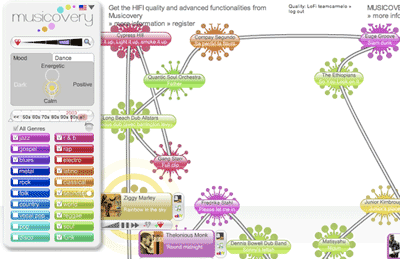Aram, Ran, and Ben.
We met today to share our backgrounds and ideas more extensively. We have reviewed several of the music sites including:
- The Hype Machine – focus on story and social connectivity. For listening, users directed to purchase from Amazon, etc. Criteria/context for blogger selection is missing.
- SP (StreamPad Beta) – definitely pre-release/beta stage. Itunes anywhere, with live concert functionality. Individual based/less social. It reaches and include image of first year ITP student.
- Ivoon – strange financial issues welcome screen follows poor registration/login design. Notion to create playlists for existing social sites not too innovative.
- Odeo – nice simple interface with ability to browse and download without registration, but no music. No social or geographic elements.
- Pandora – discussion regarding the music genom project.
- Last.fm – user friendly and includes coverage of the creative brief’s key areas.
CONCEPT:
In our conversation of these sites, our backgrounds, and many related topics, our attention has become centered around building on a “last.fm base” to add core functionality, which would provide a relatively unique answer to the question: How do I find the music I want to hear? Currently, it seems that our target audience finds music from recommendations, friends, and basic genre selection.
Our idea, inspired by a Korean website called Bugsmusic, is to integrate emotional/situational based categories, which are informed by users and a user driven ranking system. Bugsmusic introduces many complex and interesting theme selections (e.g.s. location, time and season, emotion/mood, genre, age, and weather). This new element would offer listeners the ability to expand and revise conventional associations related to music in a structured and collaborative way and hear songs and playlists that are relevant to their immediate mood, need, or situation.
Task are two part.
1) Identify strong and innovative pieces of the Bugsmusic design.
2) Define the best strategy for implementing these pieces into our users’ experience.
Following the group meeting, we self-assigned individual directions as well. Aram is researching devices that may include menu functions with similarities to our idea (likely produced by Asian companies such as Creative). Ran is exploring and analyzing Bugsmusic. My role is to consolidate and write up our ideas (this blog entry).
See Bugsmusic translation


